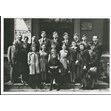- Address
- 24 Cecil Street
- Source
- Landmarks
The Labour Zionist Order was an outgrowth of the Labour Zionist party in Israel (the Mapai party). They carried out a number of different functions. They were pro-labour and pro-Zionist. They acted as a mutual benefit society—the Labour Zionist Alliance or Farband, formally known as the Jewish National Workers Alliance or Farband Labour Zionist Order. They also operated a school for children called the Farband Folks Shule (later Bialik Hebrew Day School). There was a fundraising organization that they oversaw called the Israel Histadrut of Toronto whose annual campaign raised money for the Israel Histadrut in Israel (the Federation of Labour in Israel), founded in 1920. The campaign money was used to fund economic, trade union, military, social, and cultural activities in Israel, as well as to provide a comprehensive system of health insurance and hospital services to workers. The Israel Histadrut campaign in Toronto had an autonomous executive board, however it's activities were overseen by the Labour Zionist Order.
- Address
- 24 Cecil Street
- Time Period
- 1922-
- Scope Note
- The Labour Zionist Order was an outgrowth of the Labour Zionist party in Israel (the Mapai party). They carried out a number of different functions. They were pro-labour and pro-Zionist. They acted as a mutual benefit society—the Labour Zionist Alliance or Farband, formally known as the Jewish National Workers Alliance or Farband Labour Zionist Order. They also operated a school for children called the Farband Folks Shule (later Bialik Hebrew Day School). There was a fundraising organization that they oversaw called the Israel Histadrut of Toronto whose annual campaign raised money for the Israel Histadrut in Israel (the Federation of Labour in Israel), founded in 1920. The campaign money was used to fund economic, trade union, military, social, and cultural activities in Israel, as well as to provide a comprehensive system of health insurance and hospital services to workers. The Israel Histadrut campaign in Toronto had an autonomous executive board, however it's activities were overseen by the Labour Zionist Order.
- History
- The Labour Zionist Order purchased the house at 24 Cecil Street in 1922 and established a library in it. It was called the Farband Institute.
- Category
- Political
- Organization
- Source
- Landmarks
- Address
- 150 Beverley Street
- Source
- Landmarks
By 1919 the plight of post-war Eastern European Jewry and the need for a united community voice for Canadian Jewry led to the creation of the Canadian Jewish Congress. Its founding meeting was held on March 16, 1919 in Montreal. Though it briefly maintained a tiny regional office in Toronto, the CJC remained inactive until 1933, when it fully reconvened by opening offices in Winnipeg, Montreal, and Toronto. Egmont L. Frankel was the first President of the new Central Division in Toronto. While the National Office in Montreal focused on the overarching issues of the social and economic rights of European Jewry, assistance for Jewish immigrants, and combating prejudice in Canada, the Toronto office dealt with local violent anti-Jewish demonstrations as well as continuing discrimination both in employment and in access to public recreational facilities. The structure was based on regular national biennial plenary conferences at which policies were delineated and national and regional executives were elected. Between plenary sessions, National and Regional Councils were in charge.
- Address
- 150 Beverley Street
- Time Period
- 1919-2012
- Scope Note
- By 1919 the plight of post-war Eastern European Jewry and the need for a united community voice for Canadian Jewry led to the creation of the Canadian Jewish Congress. Its founding meeting was held on March 16, 1919 in Montreal. Though it briefly maintained a tiny regional office in Toronto, the CJC remained inactive until 1933, when it fully reconvened by opening offices in Winnipeg, Montreal, and Toronto. Egmont L. Frankel was the first President of the new Central Division in Toronto. While the National Office in Montreal focused on the overarching issues of the social and economic rights of European Jewry, assistance for Jewish immigrants, and combating prejudice in Canada, the Toronto office dealt with local violent anti-Jewish demonstrations as well as continuing discrimination both in employment and in access to public recreational facilities. The structure was based on regular national biennial plenary conferences at which policies were delineated and national and regional executives were elected. Between plenary sessions, National and Regional Councils were in charge.
- History
- During the 1930s the Central Division Office moved several times and occupied offices in the following locations; Yonge St., the Bond St. Synagogue, Scheuer House, the Zionist Building, and its long-term home at 150-152 Beverley Street where it remained until its July, 1983 move to the Lipa Green Building in North York. Its activities expanded to include taking responsibility for Jewish educational standards but, by 1941, its main efforts shifted to support for Canada’s war effort. Immediately after the end of the war, the focus again shifted to Jewish immigration projects and the maintenance of Jewish identity in small communities.By 1950, the CJC’s use of the title “division” was changed to “region” to accommodate internal operational “divisions” within each region. Also, by then, the Central Region was busy expanding its programs for all Ontario Jewish communities, creating a province-wide council of youth groups, and working with the newly-created Bureau of Jewish Education (later Board of Jewish Education).
- Category
- Organization
- Source
- Landmarks
![Club One, Pioneer Women, Toronto, [ca. 1948-1952]. Ontario Jewish Archives, Blankenstein Family Heritage Centre, item 4749.|](/media/Digital Assets/4749.jpg?width=111&height=111&404=no-img.jpg)

